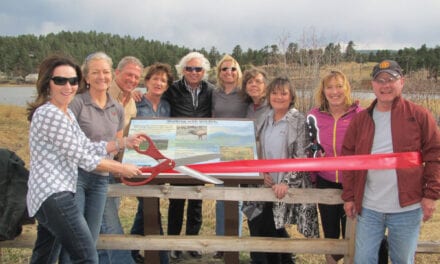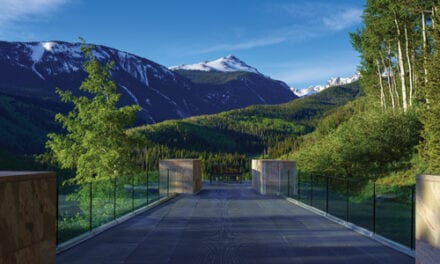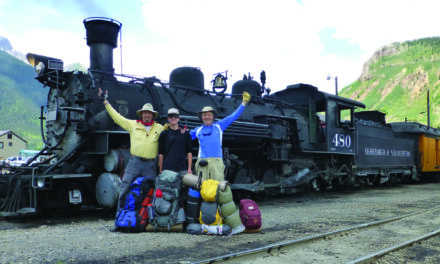
Fifty years ago, people rarely saw a moose in the Great State of Colorado. Today they’re becoming as plentiful as paintbrush.
Twenty years ago, nobody had ever seen a moose in Jeffco’s neck of the woods. Today they’re popping up like pasque flowers.
Fact is, there has always been the odd moose seen wandering Colorado’s northern latitudes, but they were mere outriders, loners, transient bulls drifting down from Wyoming without putting down roots. Why the sudden surge of rangy strangers? Whence the flood of antlered émigrés? And how will all these giants-come-lately get along with our hometown herds?
“They’ve surprised biologists and managers by exploiting non-traditional habitat communities, such as upland shrub and Gambel’s oakbrush on the Grand Mesa.”
Way back in the 1970s, state wildlife managers perceived “underutilized habitat” in Colorado’s high country and started spitballing ways to fill the void. Although many believed that Cowboy State moose would eventually colonize the Centennial State on their own, in 1978, state biologists betook themselves to goose the moose migration by transplanting 12 specimens from the Beehive State to underutilized habitat near Walden. A dozen more from Wyoming joined them the following year, and together they started utilizing their new North Park habitat for all it was worth. So fruitfully did they multiply that 12 years later, Walden moose were among 100 animals installed in the wild country near Creede. While precise figures are hard to come by, biologists with Colorado Parks & Wildlife (CPW) suspect that something like 3,500 moose now roam the Colorado Rockies from Red Feather Lakes to Pagosa Springs, and their numbers are still shooting up like penstemon in May.

If you haven’t yet met one of Colorado’s newly-crowned Kings of the Forest, introductions are in order. Please meet Alces alces shirasi, the smallest of North America’s moose subspecies, moose being the largest member of North America’s deer family. Your typical adult Shiras moose stands 6 feet at the shoulder and weighs anywhere from 800 to 1,000 pounds. It’s an aquatic creature, most comfortable in cool, marshy environments among the alpine willows that form a great part of its diet. A moose can close its nostrils to forage underwater, dive to a depth of 20 feet and swim at speeds up to 6 mph. Its fur is hollow, providing both buoyancy and excellent insulation, which helps to explain why moose prefer icy high-altitude streams, lakes and fens to the more temperate accommodations enjoyed by their smaller cousins. It also helps to explain why game managers don’t expect too much friction within the state’s Family Cervidae.
“There is very little competition between moose and other species, such as elk and deer,” says DPW spokeswoman Kara Van Hoose. “Displacement of one species by another is not wide-ranging.”
What is wide-ranging is Colorado’s expanding moose population, confounding many experts by setting up house in what most regard as marginal moose habitat.
“They’ve surprised biologists and managers by exploiting non-traditional habitat communities, such as upland shrub and Gambel’s oakbrush on the Grand Mesa, says Van Hoose. “There isn’t a hard geographical boundary for moose in Colorado.”
“Researchers in Maine have determined that collisions with moose are 13 times more deadly than collisions with deer.”
Which means it’s not impossible that we’ll be seeing more than the random Shiras right here on Bear Creek. Deriving their name from the Algonquin word “moz,” meaning “twig-eater,” moose have already become fixtures in Clear Creek County and they’re fast becoming regulars at Jefferson County Open Space.
“Moose have been reported in the Coal Creek Canyon Study Area, White Ranch Park, Centennial Cone Park, Clear Creek Canyon Park, Elk Meadow Park, Alderfer / Three Sisters Park, Flying J Ranch Park, Meyer Ranch Park, and Beaver Ranch Park,” says JCOS Natural Resources Senior Specialist Andrew Dubois. “While the number of reports in our database is demonstrating an upward trend, we are unable to determine if the increased number of moose reports corresponds to an increased number of moose in our area, or if this trend can be explained by other factors.”
Speaking of other factors, alongside their natural “Wow!” factor, moose come with elevated risk factors. On the road, the almost comically long legs that help them get around in deep mountain snow also lifts them up above many automobile hoods. If you hit one, there’s a reasonable chance they’ll wind up inside the car with you, and they probably won’t be happy about it. Researchers in Maine have determined that collisions with moose are 13 times more deadly than collisions with deer.

Off-road, moose aren’t afraid of humans, so it’s up to us to stay out of their way, not the other way around. Moose are generally easy-going, but they can get riled in a hurry, and they’re at their temperamental worst during fall mating season and spring calving season. A moose cow can be terrifying in defense of her young, and nothing will turn a tranquil grazer into a raging bull faster than your dog. In Alaska, up to 10 people are killed every year by irritated moose, and moose injure more people than any other wild animal in the Americas. Hereabouts, problems have been thankfully few.
“We did have one instance where a park visitor created a dangerous situation by attempting to feed pizza to a moose,” says Dubois. “Never attempt to approach a moose. If you’re charged, run. If you can, try to position yourself with a tree or rock between you and the moose.”
Don’t be fooled by their casual demeanor. Keep the pup on a leash and keep your distance. Because if current trends continue, you may very well meet a moose one fine day, maybe in your own backyard.
“The Evergreen and Conifer areas likely fall within the category of non-traditional habitat,” says Van Hoose, “but moose may already be using this area, and even breeding there at low densities.”
“Five of our moose reports describe mothers with associated young,” adds Dubois, “indicating that some growth and development is taking place within Jefferson County.”
Moose will never rival Evergreen’s robust elk herds, but there may yet come a time when they’re as familiar as fireweed.





